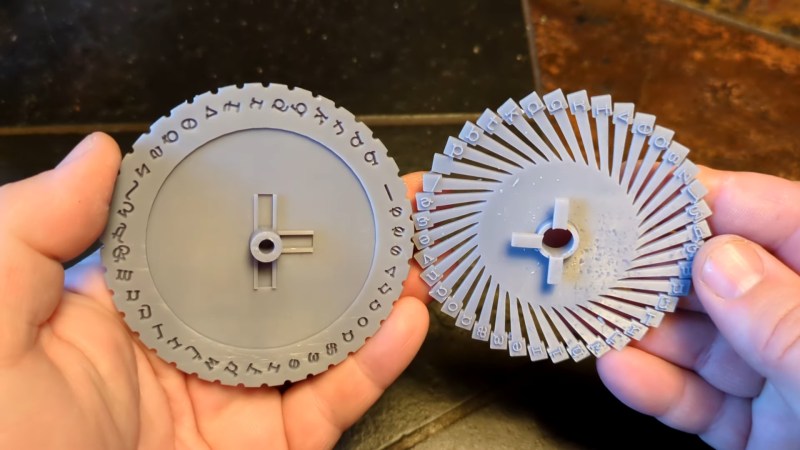[Attoparsec] loves learning languages, but says they have a hard time retaining anything. We find that hard to believe given the number of tongues that [Attoparsec] was able to translate into embossing plastic. That’s right, this project is about making custom font wheels for an embosser, formerly known as a label maker.
If you think this seems like a finicky and perhaps lengthy mission to undertake, you’re right. In case you’re unfamiliar, ye olde embosser uses both a positive and a negative of each glyph in order to impress the sticky-backed plastic strip. It all started when [Attoparsec] found out about the Dymo 1595, which comes with font wheels for both Japanese hiragana and katakana in addition to English.
After sacrificing the English wheel, it was time to model the wheel part itself. That was easy enough, but the characters themselves were another story. Because of how the thing works, the negative has to be bigger than the positive to provide enough room for the tape. After trying to achieve the right draft angle on the characters in several CAD packages, [Attoparsec] was told that it should be fairly easy in OpenSCAD, and it was.
Printing in resin took about five hours to do both wheels at once. Once [Attoparsec] had the workflow down, they were off to the races. In this video alone, they made Old English, Esperanto, the International Phonetic Alphabet, an alphabet created by playwright George Bernard Shaw, Palm Pilot input script, and of course, Tolkein’s Tengwar. Be sure to check out the video after the break.
Tired of turning the wheel of your embosser to make labels? Automate the process with a stepper motor or two.
Thanks to [smellsofbikes] and [Jonas] for the tip!
















And from the Title Photo, I thought he was making replacement daisy wheels.
That would probably be easy now that he’s done this.
+1
How much of this will survive the comment engine? One thing is sure even before posting, is there a way to mark this up in a monospaced font? Maybe inline
elementor element? Let’s try---------------------
Greek Alphabet
---------------------
Αα | Alpha
Ββ | Beta
Γγ | Gamma
Δδ | Delta
Εε | Epsilon
Ζζ | Zeta
Ηη | Eta
Θθ | Theta
Ιι | Iota
Κκ | Kappa
Λλ | Lambda
Μμ | Mu
Νν | Nu
Ξξ | Xi
Ππ | Pi
Ρρ | Rho
Σσς | Sigma uppercase ΣϾ, lowercase σ, lowercase in word-final position ς.
Ττ | Tau
Υυ | Upsilon
Φφ | Phi
Χχ | Chi
Ψψ | Psi
Ωω | Omega
code sort-of works, but not quite
Omicron?
Wow ! What an incredible project and video tutorial. I learned so much I had to watch it again. I didn’t know there was a script for Esperanto… (I learned the basics in college). In high school a friend and I use to send messages using the zodiac alphabet… Maybe that could be the next wheel. As for the Dymo labeler, it is still cool.
I would be concerned about the resin prints becoming brittle over time and breaking, especially in an application where the wheels are put under repeated stresses like this one. Very cool project, though!
You may cast them in aluminum if you wish. :)
Seriously, the originals are ABS anyway. Just get something tough and only mildly squishy, and you’re good.
You joke, but makers do tend to overlook white metal casting, which might be a good choice here.
For those who don’t know, white metals (like pewter) melt at oven temperatures, which means you can easily cast them in silicone molds. It’s no substitute for stainless but you can make pretty durable parts for some purposes.
I think here I’d rather have a more elastic plastic/resin than the white metal that I expect would fatigue and break somewhere. Though it is one of those areas where either are probably just about ok, but you really need to test it in practice to know how well it holds up (and then only ever use embossing tape of the same material as a tougher/more elastic/thicker/thiner tape changes the dynamics enough that it might swing the other way).
It depends on the resin you use, my company use Formlabs materials which have excellent mechanical properties – https://sgd3d.co.uk/services/sla-3d-printing/
Another option is to post-process the prints and electroplate these. I know that electroplated Rigid 10K parts (we offer this) are being used on the international space station as they have crazy mechanical properties for resin.
I saw language learning and had to chime in: after learning several languages, it does get harder to remember things. They all start to smoosh together. By the time you’ve learned several, you start to bump against the age related memory barriers and you’re good to get a couple new words in the recognizable category per day, but meaning is another story altogether.
Bravo for reenforcing language learning via side interests.
The Commenter Formerly Known As Ren said: “Omicron?”
Doh!
Οο | OmicronAgain – Dropped to the very bottom of the comment thread even though it was a REPLY. I swear – NOT MY FAULT!
Thanks, I was wondering if there was another Greek alphabet,
I wasn’t trying to sniper you.
Cyrillic, Armenian, Georgian, Korean, Coptic, Cherokee, Ethiopic, Thai, Canadian Aboriginal syllabics, the possibilities are endless, well depending on how many characters you can get on a wheel.
How about Klingon?
This is incredible! Any chance you would do a custom commission? I don’t have the 3D printer setup to build my own, but I desperately want a custom font for my embosser. Amazing work!